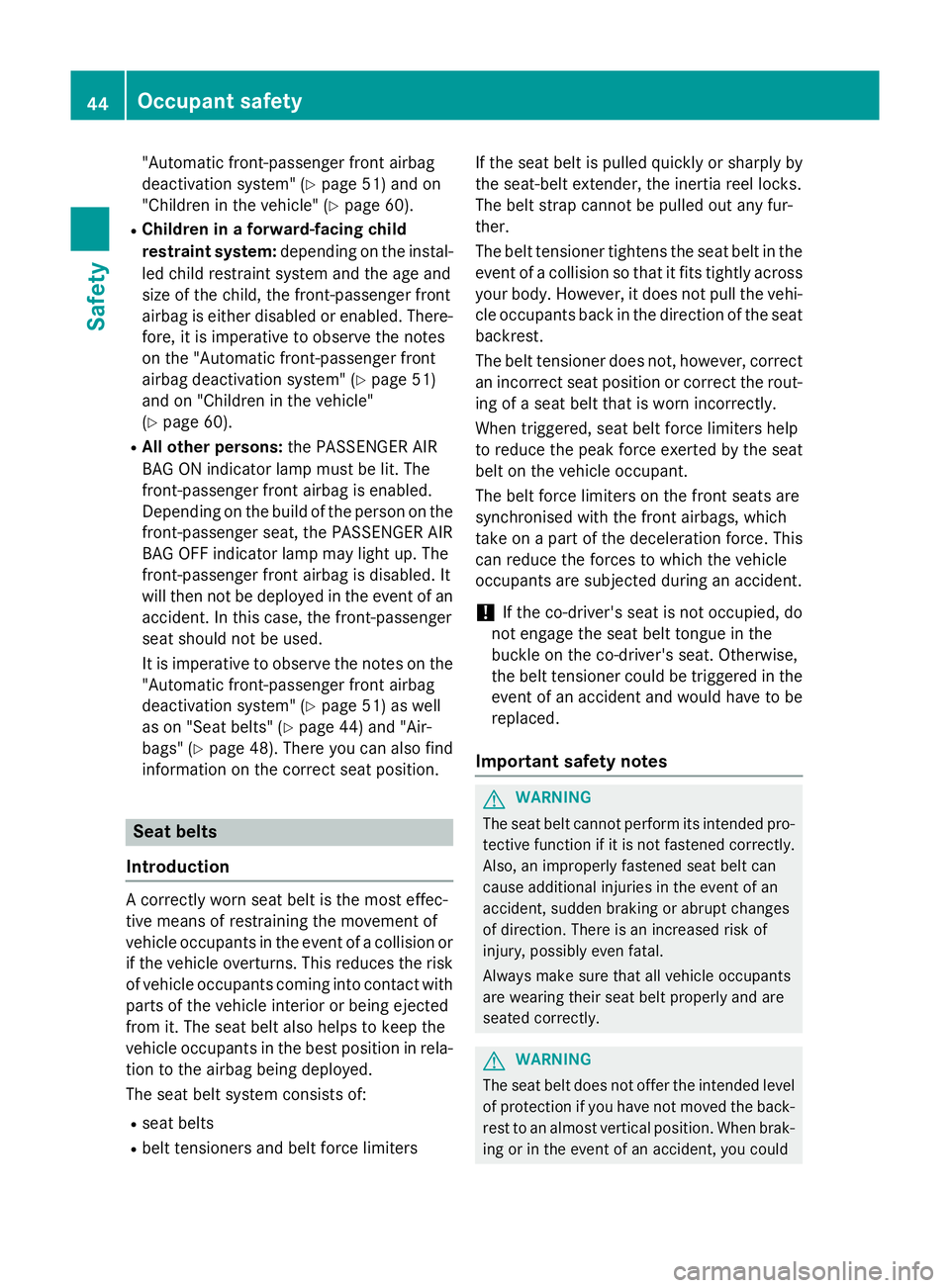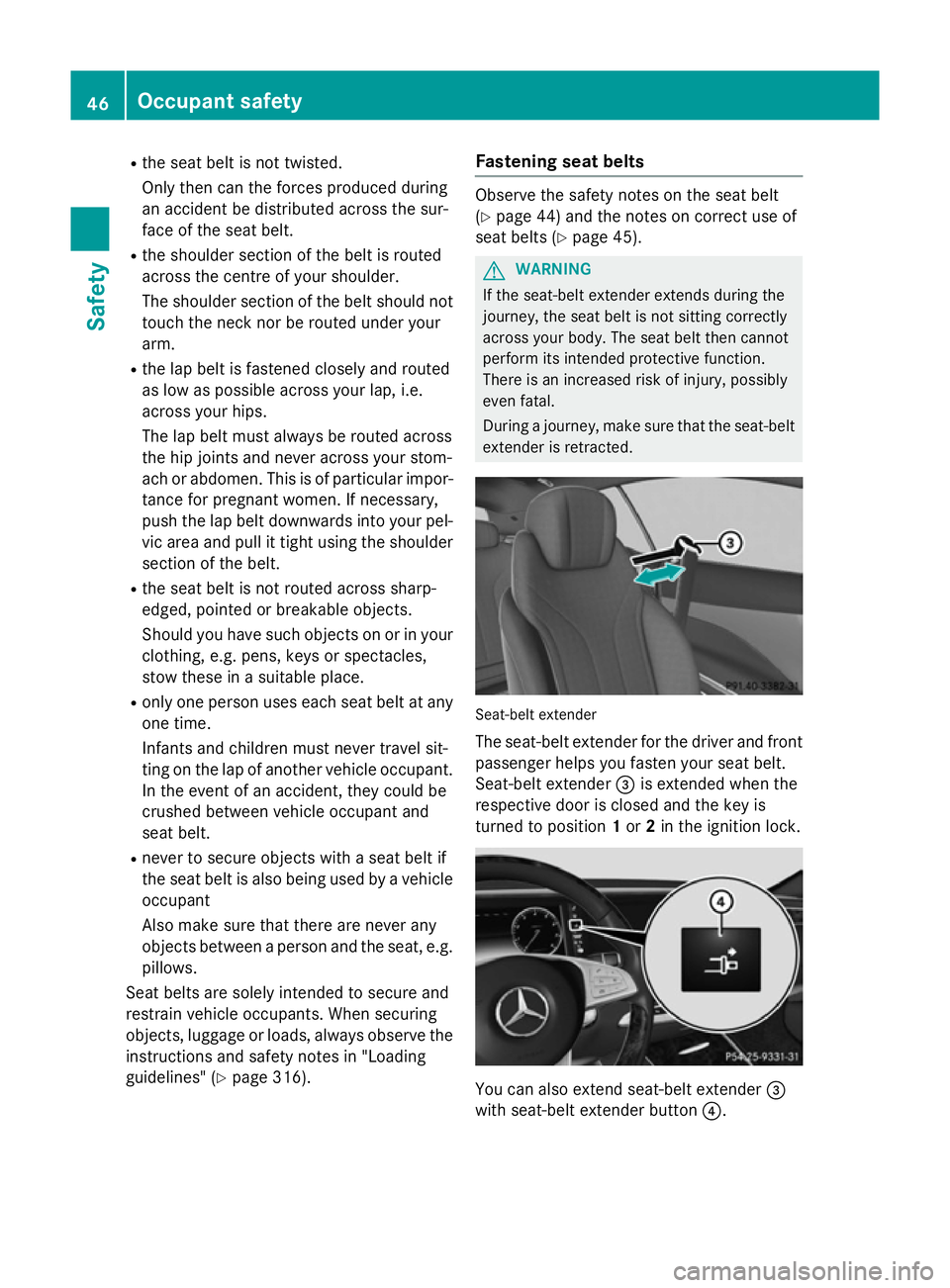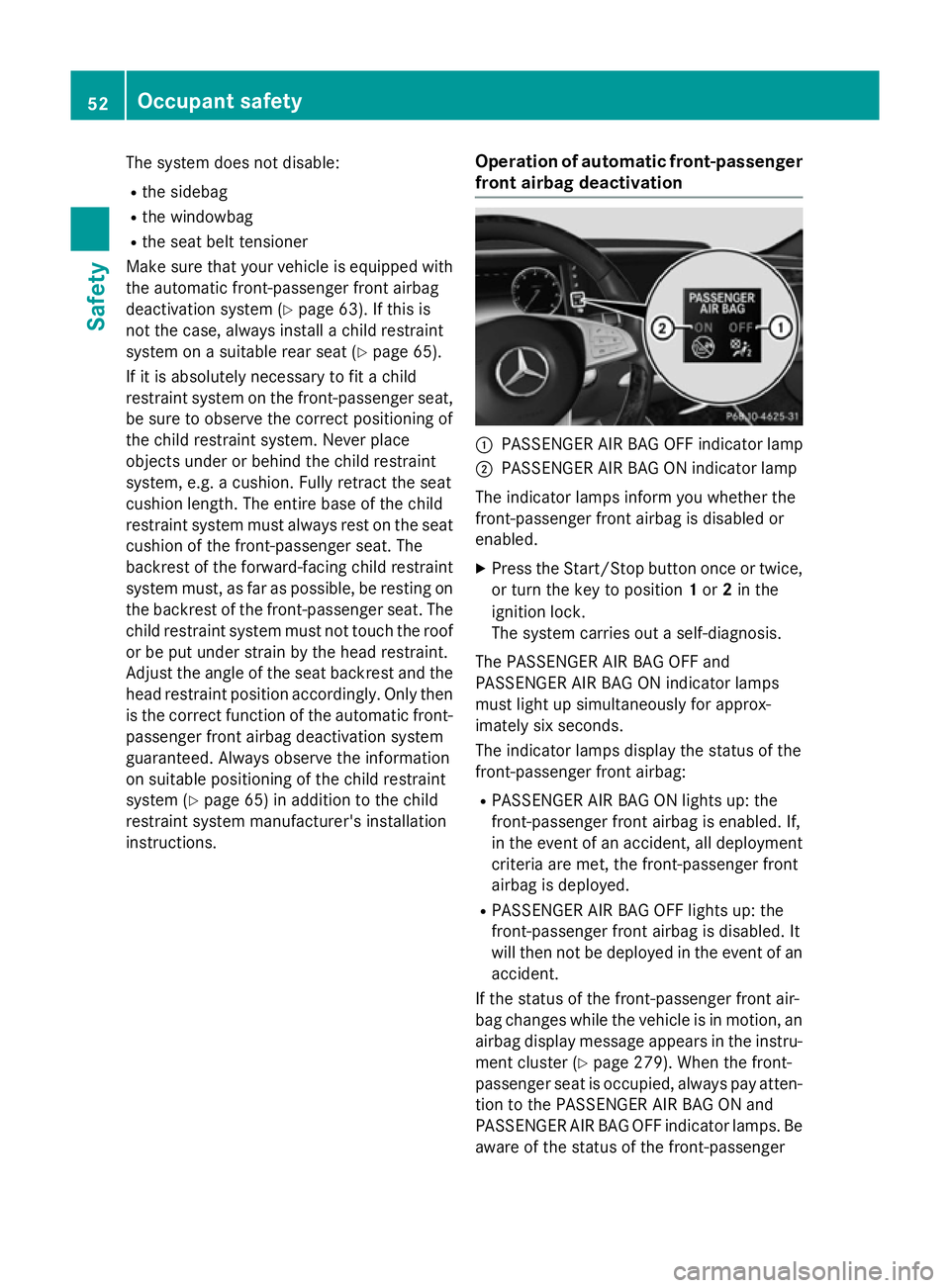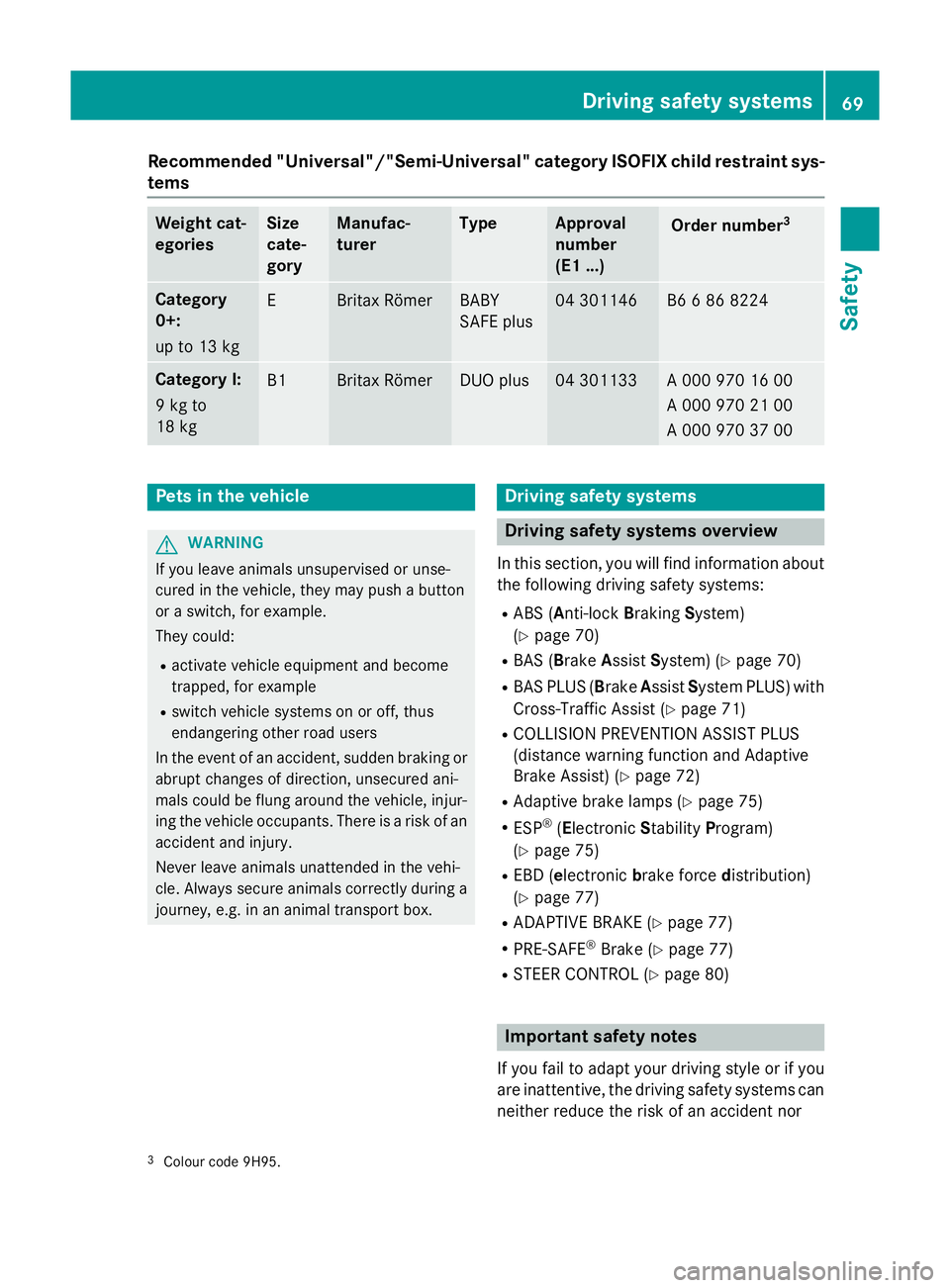2015 MERCEDES-BENZ S-CLASS COUPE child lock
[x] Cancel search: child lockPage 10 of 417

Care
360° camera ................................ .350
Automatic car wash ....................... 345
Carpets .......................................... 353
Display .......................................... .351
Exhaust pipe .................................. 351
Exterior lighting ............................ .349
Gear or selector lever .................... 352
High-pressure cleaner .................... 347
Interior .......................................... .351
Matt paintwork .............................. 348
Night View Assist Plus ................... 351
Notes ............................................. 345
Paint .............................................. 347
Plastic trim ................................... .352
Reversing camera .......................... 350
Roof lining ...................................... 353
Seat belt ........................................ 353
Seat cover ..................................... 352
Sensors ......................................... 349
Steering wheel ............................... 352
Trim pieces ................................... .352
Washing by hand ........................... 347
Wheels .......................................... .348
Windows ........................................ 348
Wiper blades .................................. 349
Wooden trim .................................. 352
CD player (on-board computer) ........254
Central locking
Locking/unlocking (key ).................. 85
Centre console
Overview .......................................... 36
Stowage space .............................. 317
Centre console in the rear com-
partment
Stowage compartment .................. 319
Changing the media source ............. 254
Child
Restraint system .............................. 61
Child seat
Forward-facing restraint system ...... 64
ISOFIX .............................................. 62
On the front-passenger sea t............ 63
Rearward-facing restraint system .... 64
Recommendations ........................... 68
Suitable positions ............................ 65
Top Tether ....................................... 62
Cigarette lighter ................................ 324 Cleaning
Mirror turn signal ........................... 349
Climate control
Automatic air conditioning ............. 139
Auxiliary heating/ventilation .......... 149
Controlling automaticall y............... 142
Convenience opening/closing
(air-recirculation mode) ................. 146
Cooling with air dehumidification .. 141
Demisting the windows .................. 144
Demisting the windscreen ............. 144
ECO start/stop function ................ 140
Indicator lamp ................................ 142
Ionisation ....................................... 149
Notes on using the automatic cli-
mate control .................................. 140
Overview of systems ...................... 138
Perfume atomizer .......................... 147
Problem with the rear window
heating .......................................... 146
Problems with cooling with air
dehumidification ............................ 142
Setting the air distribution ............. 143
Setting the air vents ...................... 155
Setting the airflow ......................... 144
Setting the climate mod e............... 143
Setting the temperature ................ 143
Switching air-recirculation mode
on/of f............................................ 146
Switching on/of f........................... 141
Switching residual heat on/off ...... 147
Switching the rear window heat-
ing on/of f...................................... 145
Switching the synchronisation
function on and off ........................ 144
Cockpit
Overview .......................................... 30
COLLISION PREVENTION ASSIST
PLUS
Activating/deactivating ................. 260
Display message ............................ 274
Operation/note s.............................. 72
COMAND display
Cleaning ......................................... 351
Combination switch .......................... 128
Consumption statistics (on-board
computer) .......................................... 250
Convenience closing feature ............ 101 Index
7
Page 15 of 417

General notes ................................ 330
Important safety notes .................. 330
Opening/closing the garage door .. 332
Programming (button in the rear-
view mirror
) ................................... 330
Synchronising the ro lling code .......331
Gear indicator (on-board com-
puter, Mercedes-AMG vehicles) ....... 265
Gearshift program
SETUP (on-board computer) .......... 265
Genuine Mercedes-Benz parts ........... 23
Glove compartment .......................... 317H
HANDS-FREE ACCESS .......................... 96
Hazard warning lamps ......................128
Head restraints
Adjusting ....................................... 111
Adjusting (manually) ..................... .111
Adjusting (rear) .............................. 112
Head-up display
Adjusting the brightness ................ 262
Displays and operating .................. 247
Function/notes ............................ .247
Important safety notes .................. 247
Selecting displays .......................... 261
Setting the position ....................... 262
Storing settings (memory func-
tion) ............................................... 123
Headbag
Display message ............................ 277
Headlamp flasher .............................. 128
Headlamps
Misting up ...................................... 132
see Automatic headlamp mode
Heater booster function ................... 153
Heating
see Climate control
High-pressure cleaners .................... 347
Hill start assist .................................. 164
HOLD function
Activating ....................................... 206
Activation conditions ..................... 206
Deactivating ................................... 206
Display message ............................ 291
Function/notes ............................ .205
General notes ................................ 205 Horn
...................................................... 30
HUD
see Head-up display I
Ignition lock see Key positions
Immobiliser .......................................... 80
Indicator and warning lamp
Restraint system ............................ 309
Indicator and warning lamps
COLLISION PREVENTION ASSIST
PLUS .............................................. 312
Coolant .......................................... 310
Engine diagnostics ......................... 310
Indicator lamps
Display message ............................ 280
see Warning and indicator lamps
Indicators
see Turn signals
Insect protection on the radiator .... 340
Instrument cluster
Overview .......................................... 32
Warning and indicator lamps ........... 33
Instrument cluster lighting .............. 244
Intelligent Light System
Activating/deactivating ................. 262
Display message ............................ 282
Overview ........................................ 129
Setting the dipped-beam head-
lamps for driving on the right/left .. 263
Interior lighting
Control .......................................... .132
Emergency lighting ........................ 133
Overview ........................................ 132
Reading lamp ................................. 132
Interior motion sensor
Deactivating ..................................... 82
Function .......................................... .81
Priming ............................................ 81
Switching off .................................... 82
ISOFIX child seat securing system ....62 J
Jack Storage location ............................3 5712
Index
Page 47 of 417

"Automatic front-passenger front airbag
deactivation system" (Y page 51) and on
"Children in the vehicle" (Y page 60).
R Children in a forward-facing child
restraint system: depending on the instal-
led child restraint system and the age and
size of the child, the front-passenger front
airbag is either disabled or enabled. There-
fore, it is imperative to observe the notes
on the "Automatic front-passenger front
airbag deactivation system" (Y page 51)
and on "Children in the vehicle"
(Y page 60).
R All other persons: the PASSENGER AIR
BAG ON indicator lamp must be lit. The
front-passenger front airbag is enabled.
Depending on the build of the person on the
front-passenger seat, the PASSENGER AIR
BAG OFF indicator lamp may light up. The
front-passenger front airbag is disabled. It
will then not be deployed in the event of an accident. In this case, the front-passenger
seat should not be used.
It is imperative to observe the notes on the
"Automatic front-passenger front airbag
deactivation system" (Y page 51) as well
as on "Seat belts" (Y page 44) and "Air-
bags" (Y page 48). There you can also find
information on the correct seat position. Seat belts
Introduction A correctly worn seat belt is the most effec-
tive means of restraining the movement of
vehicle occupants in the event of a collision or
if the vehicle overturns. This reduces the risk of vehicle occupants coming into contact with
parts of the vehicle interior or being ejected
from it. The seat belt also helps to keep the
vehicle occupants in the best position in rela-
tion to the airbag being deployed.
The seat belt system consists of:
R seat belts
R belt tensioners and belt force limiters If the seat belt is pulled quickly or sharply by
the seat-belt extender, the inertia reel locks.
The belt strap cannot be pulled out any fur-
ther.
The belt tensioner tightens the seat belt in the
event of a collision so that it fits tightly across
your body. However, it does not pull the vehi- cle occupants back in the direction of the seat
backrest.
The belt tensioner does not, however, correct an incorrect seat position or correct the rout-
ing of a seat belt that is worn incorrectly.
When triggered, seat belt force limiters help
to reduce the peak force exerted by the seat
belt on the vehicle occupant.
The belt force limiters on the front seats are
synchronised with the front airbags, which
take on a part of the deceleration force. This
can reduce the forces to which the vehicle
occupants are subjected during an accident.
! If the co-driver's seat is not occupied, do
not engage the seat belt tongue in the
buckle on the co-driver's seat. Otherwise,
the belt tensioner could be triggered in the
event of an accident and would have to be
replaced.
Important safety notes G
WARNING
The seat belt cannot perform its intended pro- tective function if it is not fastened correctly. Also, an improperly fastened seat belt can
cause additional injuries in the event of an
accident, sudden braking or abrupt changes
of direction. There is an increased risk of
injury, possibly even fatal.
Always make sure that all vehicle occupants
are wearing their seat belt properly and are
seated correctly. G
WARNING
The seat belt does not offer the intended level of protection if you have not moved the back-
rest to an almost vertical position. When brak-
ing or in the event of an accident, you could 44
Occupant safetySafety
Page 49 of 417

R
the seat belt is not twisted.
Only then can the forces produced during
an accident be distributed across the sur-
face of the seat belt.
R the shoulder section of the belt is routed
across the centre of your shoulder.
The shoulder section of the belt should not
touch the neck nor be routed under your
arm.
R the lap belt is fastened closely and routed
as low as possible across your lap, i.e.
across your hips.
The lap belt must always be routed across
the hip joints and never across your stom-
ach or abdomen. This is of particular impor-
tance for pregnant women. If necessary,
push the lap belt downwards into your pel-
vic area and pull it tight using the shoulder section of the belt.
R the seat belt is not routed across sharp-
edged, pointed or breakable objects.
Should you have such objects on or in your
clothing, e.g. pens, keys or spectacles,
stow these in a suitable place.
R only one person uses each seat belt at any
one time.
Infants and children must never travel sit-
ting on the lap of another vehicle occupant. In the event of an accident, they could be
crushed between vehicle occupant and
seat belt.
R never to secure objects with a seat belt if
the seat belt is also being used by a vehicle
occupant
Also make sure that there are never any
objects between a person and the seat, e.g. pillows.
Seat belts are solely intended to secure and
restrain vehicle occupants. When securing
objects, luggage or loads, always observe the instructions and safety notes in "Loading
guidelines" (Y page 316). Fastening seat belts Observe the safety notes on the seat belt
(Y
page 44) and the notes on correct use of
seat belts (Y page 45). G
WARNING
If the seat-belt extender extends during the
journey, the seat belt is not sitting correctly
across your body. The seat belt then cannot
perform its intended protective function.
There is an increased risk of injury, possibly
even fatal.
During a journey, make sure that the seat-belt extender is retracted. Seat-belt extender
The seat-belt extender for the driver and front passenger helps you fasten your seat belt.
Seat-belt extender =is extended when the
respective door is closed and the key is
turned to position 1or 2in the ignition lock. You can also extend seat-belt extender
=
with seat-belt extender button ?.46
Occupant safetySafety
Page 55 of 417

The system does not disable:
R the sidebag
R the windowbag
R the seat belt tensioner
Make sure that your vehicle is equipped with
the automatic front-passenger front airbag
deactivation system (Y page 63). If this is
not the case, always install a child restraint
system on a suitable rear seat (Y page 65).
If it is absolutely necessary to fit a child
restraint system on the front-passenger seat,
be sure to observe the correct positioning of
the child restraint system. Never place
objects under or behind the child restraint
system, e.g. a cushion. Fully retract the seat
cushion length. The entire base of the child
restraint system must always rest on the seat cushion of the front-passenger seat. The
backrest of the forward-facing child restraint
system must, as far as possible, be resting on the backrest of the front-passenger seat. The
child restraint system must not touch the roof or be put under strain by the head restraint.
Adjust the angle of the seat backrest and the
head restraint position accordingly. Only then is the correct function of the automatic front- passenger front airbag deactivation system
guaranteed. Always observe the information
on suitable positioning of the child restraint
system (Y page 65) in addition to the child
restraint system manufacturer's installation
instructions. Operation of automatic front-passenger
front airbag deactivation :
PASSENGER AIR BAG OFF indicator lamp
; PASSENGER AIR BAG ON indicator lamp
The indicator lamps inform you whether the
front-passenger front airbag is disabled or
enabled. X Press the Start/Stop button once or twice,
or turn the key to position 1or 2in the
ignition lock.
The system carries out a self-diagnosis.
The PASSENGER AIR BAG OFF and
PASSENGER AIR BAG ON indicator lamps
must light up simultaneously for approx-
imately six seconds.
The indicator lamps display the status of the
front-passenger front airbag:
R PASSENGER AIR BAG ON lights up: the
front-passenger front airbag is enabled. If,
in the event of an accident, all deployment
criteria are met, the front-passenger front
airbag is deployed.
R PASSENGER AIR BAG OFF lights up: the
front-passenger front airbag is disabled. It
will then not be deployed in the event of an accident.
If the status of the front-passenger front air-
bag changes while the vehicle is in motion, an
airbag display message appears in the instru-
ment cluster (Y page 279). When the front-
passenger seat is occupied, always pay atten-
tion to the PASSENGER AIR BAG ON and
PASSENGER AIR BAG OFF indicator lamps. Be aware of the status of the front-passenger 52
Occupant safetySafety
Page 63 of 417

PRE-SAFE
®
PLUS takes the following meas-
ures depending on the hazardous situation
detected:
R if the radar sensor system detects that a
head-on collision is imminent, the seat
belts are pre-tensioned
R if the radar sensor system detects that a
rear-end collision is imminent:
- the rear hazard warning lamps are acti-
vated and flash at a higher frequency
- the brake pressure is increased if the
driver applies the brakes when the vehi-
cle is stationary
- the seat belts are pre-tensioned
The PRE-SAFE ®
PLUS braking application is
cancelled:
R if the accelerator pedal is depressed when
a gear is engaged
R if the risk of a collision passes or is no lon-
ger detected
R if DISTRONIC PLUS indicates an intention
to pull away
If the hazardous situation passes without
resulting in an accident, the original settings
are restored. Automatic measures after an acci-
dent
Immediately after an accident, the following
measures are implemented, depending on
the type and severity of the impact:
R the hazard warning lamps are activated
R the emergency lighting is activated
R the vehicle doors are unlocked
R the front side windows are lowered
R the electrically adjustable steering wheel is
raised
R the engine is switched off and the fuel sup-
ply is cut off
R vehicles with the Mercedes-Benz emer-
gency call system: automatic emergency
call Children in the vehicle
Important safety notes
Accident statistics show that children
secured in the rear seats are safer than chil-
dren secured in the front-passenger seat. For this reason, Mercedes-Benz strongly advises
that you install a child restraint system on a
rear seat. Children are generally better pro-
tected there.
If a child younger than twelve years old and
under 1.50 m in height is travelling in the
vehicle:
R always secure the child in a child restraint
system suitable for Mercedes-Benz vehi-
cles. The child restraint system must be
appropriate to the age, weight and size of
the child.
R be sure to observe the instructions and
safety notes in this section in addition to
the child restraint system manufacturer's
installation instructions.
R always pay attention to the instructions
and safety notes on the automatic front-
passenger front airbag deactivation system (Y page 51). G
WARNING
If you leave children unattended in the vehi-
cle, they may be able to set the vehicle in
motion if, for example, they:
R release the parking brake
R shift the automatic transmission out of park
position P
R start the engine
In addition, they may operate vehicle equip-
ment and become trapped. There is a risk of
an accident and injury.
When leaving the vehicle, always take the key
with you and lock the vehicle. Never leave
children unattended in the vehicle. G
WARNING
If persons (particularly children) are exposed
to heat or cold for a prolonged period, there is 60
Children in the vehicleSafety
Page 72 of 417

Recommended "Universal"/"Semi-Universal" category ISOFIX child restraint sys-
tems Weight cat-
egories Size
cate-
gory Manufac-
turer Type Approval
number
(E1 ...)
Order number
3 Category
0+:
up to 13 kg
E Britax Römer BABY
SAFE plus 04 301146 B6 6 86 8224
Category I:
9 kg to
18 kg
B1 Britax Römer DUO plus 04 301133 A 000 970 16 00
A 000 970 21 00
A 000 970 37 00
Pets in the vehicle
G
WARNING
If you leave animals unsupervised or unse-
cured in the vehicle, they may push a button
or a switch, for example.
They could:
R activate vehicle equipment and become
trapped, for example
R switch vehicle systems on or off, thus
endangering other road users
In the event of an accident, sudden braking or
abrupt changes of direction, unsecured ani-
mals could be flung around the vehicle, injur-
ing the vehicle occupants. There is a risk of an accident and injury.
Never leave animals unattended in the vehi-
cle. Always secure animals correctly during a
journey, e.g. in an animal transport box. Driving safety systems
Driving safety systems overview
In this section, you will find information about the following driving safety systems:
R ABS ( Anti-lock BrakingSystem)
(Y page 70)
R BAS ( Brake Assist System) (Y page 70)
R BAS PLUS (B rakeAssist System PLUS) with
Cross-Traffic Assist (Y page 71)
R COLLISION PREVENTION ASSIST PLUS
(distance warning function and Adaptive
Brake Assist) (Y page 72)
R Adaptive brake lamps (Y page 75)
R ESP ®
(Electronic StabilityProgram)
(Y page 75)
R EBD ( electronic brake force distribution)
(Y page 77)
R ADAPTIVE BRAKE (Y page 77)
R PRE-SAFE ®
Brake (Y page 77)
R STEER CONTROL (Y page 80) Important safety notes
If you fail to adapt your driving style or if you
are inattentive, the driving safety systems can neither reduce the risk of an accident nor
3 Colour code 9H95. Driving safety systems
69Safety Z
Page 74 of 417

Braking
X
Keep the brake pedal depressed firmly until
the emergency braking situation is over.
ABS prevents the wheels from locking.
The brakes will function as usual once you
release the brake pedal. BAS is deactivated. BAS PLUS (Brake Assist System
PLUS) with Cross-Traffic Assist
General notes BAS PLUS can help you to minimise the risk of
a collision with a vehicle or a pedestrian and
reduce the effects of such a collision. If BAS
PLUS detects a danger of collision, you are
assisted when braking.
i Pay attention to the important safety
notes in the "Driving safety systems" sec-
tion (Y page 69).
BAS PLUS is only available on vehicles with
the Driving Assistance Plus package.
For BAS PLUS to assist you when driving, the radar sensor system and the camera system
must be operational.
With the help of a sensor system and a cam-
era system, BAS PLUS can detect obstacles:
R that are in the path of your vehicle for an
extended period of time
R that cross the path of your vehicle
In addition, pedestrians in the path of your
vehicle can be detected.
BAS PLUS detects pedestrians using typical
characteristics such as the body contours
and posture of a person standing upright.
If the radar sensor system or the camera sys- tem is malfunctioning, BAS PLUS functions
are restricted or no longer available. The
brake system is still available with complete
brake boosting effect and BAS.
i Observe the restrictions described in the
"Important safety notes" section
(Y page 71). Important safety notes G
WARNING
BAS PLUS cannot always clearly identify
objects and complex traffic situations.
In such cases, BAS PLUS may:
R intervene unnecessarily
R not intervene
There is a risk of an accident.
Always pay careful attention to the traffic sit- uation and be ready to brake. Terminate the
intervention in a non-critical driving situation. G
WARNING
BAS PLUS cannot always clearly identify peo- ple, this is especially the case if they are mov-
ing. BAS PLUS cannot intervene in these
cases. There is a risk of an accident.
Always pay careful attention to the traffic sit-
uation and be ready to brake. G
WARNING
BAS PLUS does not react:
R to small people, e.g. children
R to animals
R to oncoming vehicles
R when cornering
As a result, BAS PLUS may not intervene in all
critical situations. There is a risk of an acci-
dent.
Always pay careful attention to the traffic sit- uation and be ready to brake.
In the event of snowfall or heavy rain, detec-
tion can be impaired.
Detection by the radar sensor system is also
impaired in the event of:
R dirt on the sensors or obscured sensors
R interference by other radar sources
R strong radar reflections, for example, in
multi-storey car parks
R a narrow vehicle travelling in front, e.g. a
motorcycle Driving safety systems
71Safety Z